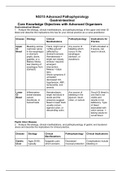N5315 Advanced Pathophysiology
Gastrointestinal Core Knowledge Objectives with Advanced Organizers
Gastrointestinal Bleeds
1. Analyze the etiology, clinical manifestations, and pathophysiology of the upper and lower GI bleed and describe the implications this has for your clinical practice as a nurse practitioner. DiseaseEtiology Clinical ManifestationsPathophysiology Implications for Practice
Upper GI BleedBleeding varices (varicose veins) in the esophagus or stomach, peptic ulcers, gastritis, or a Mallory-Weiss tear (tearing of esophagus from stomach)Frank, bright red or “coffee ground” (affected by stomach) emesis
Hematemesis = bright red, bloody emesis= requires emergent intervention.
Melena = black tarry.
Shock symptoms if untreated: decreased CO, hypotension, ARF, tachycardia, and anemia.Any source of bleeding which occurs in the esophagus, stomach, or duodenum.If left untreated or
if severe, can result in shock.
Lower GI BleedInflammatory bowel disease, cancer, diverticula, or hemorrhoidsHematochezia: bright red blood in stools and the presence suggest bleed in lower track usually rectum, sigmoid colon, or descending colon.Any source of bleeding in the jejunum, ileum, colon, or rectum.Occult GI bleed is
one that is not visible and results in iron deficiency. Type of bleed associated with colon cancer. = testing stools for occult blood
Peptic Ulcer Disease
2. Analyze the etiology, clinical manifestations, and pathophysiology of gastric and duodenal ulcers and describe the implications for clinical practice. DiseaseEtiologyClinical ManifestationsPathophysiology Clinical Implications
Gastric UlcerAges 55-65, typically Epigastric pain which worsens Decreased mucosal protectionComplications include
bleeding or scaused by NSAIDs.
Chronic use of
NSAIDs suppresses mucosal prostaglandin synthesis, resulting in decreased bicarbonate secretion and mucin productionwhen eating, melena, hematemesis or coffee ground emesis.or increased acid production.
Infection with H. pylori. perforation. If a perforation occurs, luminal contents can escape into the peritoneum and cause
peritonitis.
Treatment is similar to
duodenal ulcer treatment. See p. 1437
Duodenal
UlcersYounger patients
More common
than any other
type of ulcersEpigastric pain relieved by food. Pain will recur when stomach is empty, which may
be 30min-2 hr after eating. Pain is relieved by eating food or antacids.Melena or hematemesis is
also presentAcid and pepsin concentration in the duodenum penetrating the mucosal barrier and lead to ulcerationEndoscopic evaluation.
Radioimmunoassay of
gastrin levels to identify ulcers associated with carcinomas. Urea breath test.
Management is aimed
at relieving the causes and effects of acidity and preventing
complications. Antacids, PPI, H2 blockers, eradication of H. pylori , ulcer coating agents such as sucralfate, surgical
resection for perforation, obstruction or peritonitis.
Risk of duodenal ulcers may be reduced with diet high
in vit A and fiber.
Disorders of the Intestines
3. Differentiate between the etiology, clinical manifestations, and pathophysiology of disorders of the small and large intestines.
a. Analyze the etiology, clinical manifestations, and pathophysiology of ulcerative colitis and crohn’s disease and describe the implications on nutritional status.
DiseaseEtiology Clinical Pathophysiology Nutrition Manifestations Implications
Ulcerative
ColitisUnknown origin, associated with genetic factors, alterations in epithelial cell barrier functions, immunopathology related to abnormal T cell reactions to commensal microflora and other luminal antigensChronic, recurrent, bloody
diarrhea. Febrile,
polyarthritis, uveitis, sclerosing cholangitis, erythema nodosum, and pyoderma gangrenosum.Inflammatory disease of large intestine. Like Crohn’s it has periods of remission and exacerbations. Severe inflammation and ulcerations of large intestine which begins in rectum and involves entire large intestine. It only affects colon (not small intestine)
and does not have skipped lesions no transmural inflammations and ulcerations = it remains superficial.Complications include toxic megacolon, colon
perforation, and colorectal adenocarcinoma. Increase risk for colon cancer.
Nicotine has a protective effect.
In extreme cases IV fluids and IV nutrition
Crohn’s DiseaseAffects persons in their 20s-30s and of Jewish descent.
Causes include infectious agents (viruses or bacteria), autoimmune, psychosomatic, and impaired T-
cell immunity.Abdominal pain, diarrhea, dehydration, bloody stools, malabsorption, malnutrition, weight loss (most nutrients absorbed in small intestine), intestinal obstruction from chronic inflammation, fistulas (abnormal tracts/channels that develop in the presence of inflammation), and perforation of the intestine. They can develop strictures which Inflammatory disorder of GI tract with exacerbations and remissions. May affect any portion of the GI tract (mouth to anus) but most often in the ileum or proximal colon.
Pathophys includes
transmural involvement of the affected area (entire wall of the intestine is affected) and presence of skip lesions. This means that there are healthy, unaffected tissue surrounded by diseased tissue which are randomlyIncreased risk of colon cancer.
If ileum is involved, one can have vit B12 deficiency anemia, folic acid and vit d and calcium. Loss of protein leading to hypoalbuminemia




